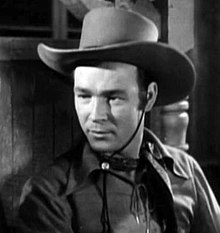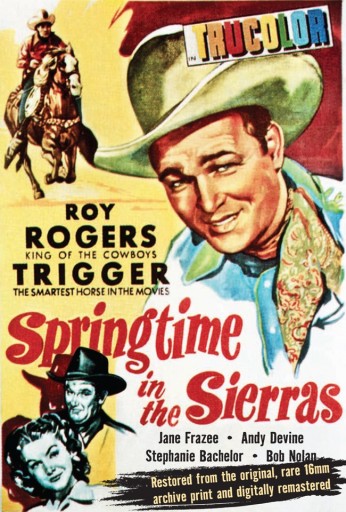Now we turn to a very well known star of film and TV of course Roy Rogers, popular to kids of the fifties and before mainly because of his comics – certainly in England that is – and the films he made of which there are many.
Most of his films were 60 or 70 minute B features but as you will see below he made a very good living from them. However in 1952 he shared star billing with Bob Hope and Jane Russell in the brilliant ‘SON OF PALEFACE’
Roy Rogers, born Leonard Franklin Slye (November 5, 1911 – July 6, 1998) inCincinnati, Ohio and moved to California to become a singer. He quickly formed a Western cowboy music group called the Sons of the Pioneers with Bob Nolan and Tim Spencer and in 1934 the group hit it big with songs like “Cool Water” and “Tumbling Tumbleweeds”. He made his first film appearance in 1935 and worked steadily in western films including a large supporting role as a singing cowboy while still billed as Leonard Slye. In 1938 Gene Autry temporarily walked out on his movie contract and needing someone to quickly replace him Republic Pictures decided on a name change and Leonard Slye was rechristened “Roy Rogers” and he then took the lead in Under Western Stars.
What a break that was because quite quickly he became a matinee idol and American legend. He was then a competitor for Gene Autry as the nation’s favourite singing cowboy.
In addition to his own movies, Rogers played a supporting role in the John Wayne classic Dark Command (1940). Rogers became a major box office attraction.
In the Motion Picture Herald Top Ten Money-Making Western Stars poll, Rogers was listed for 15 consecutive years from 1939 to 1954, holding first place from 1943 to 1954. He appeared in the similar Box Office poll from 1938 to 1955, holding first place from 1943 to 1952. (In the final three years of that poll he was second only to Randolph Scott.) Although these two polls are really an indication only of the popularity of series stars, Rogers also appeared in the Top Ten Money Makers Poll of all films in 1945 and 1946.
Rogers was an idol for many children through his films and television shows. Most of his postwar films were in Trucolor during an era when almost all other B westerns were black-and-white.
With money from not only Rogers’ films but his own public appearances going to Republic Pictures, Rogers brought a clause into a 1940 contract with the studio where he would have the right to his likeness, voice and name for merchandising. There were Roy Rogers action figures, cowboy adventure novels, and playsets, as well as a comic strip, a long-lived Dell Comics comic book series (Roy Rogers Comics) and a variety of marketing successes. Roy Rogers was second only to Walt Disney in the amount of items featuring his name. The Sons of the Pioneers continued their popularity, and they have never stopped performing from the time Rogers started the group, replacing members as they retired or passed away (all original members are deceased). Although Rogers was no longer an active member, they often appeared as Rogers’ backup group in films, radio, and television, and Rogers would occasionally appear with them in performances up until his death. In August 1950, Evans and Rogers had a daughter, Robin Elizabeth, who had Down Syndrome and died of complications with mumps shortly before her second birthday. Evans wrote about losing their daughter in her book Angel Unaware.
Rogers and Evans were also well known as advocates for adoption and as founders and operators of children’s charities. They adopted several children. Both were outspoken Christians. In Apple Valley, California, where they made their home, numerous streets and highways as well as civic buildings have been named after them in recognition of their efforts on behalf of homeless and handicapped children.
Rogers and Evans’s famous theme song, “Happy Trails”, was written by Dale Evans; they sang it as a duet to sign off their television show. In the autumn of 1962, the couple co-hosted a comedy-western-variety program, The Roy Rogers and Dale Evans Show but it wascancelled after three months. Rogers also owned a Hollywood production company which handled his own series as well as others..
Below is one of the many films that Roy Rogers starred in in the late fifties – available now on DVD from the original Trucolor print :-
Directed by William Witney Associate Producer: Edward J. White Original Screen Play by A. Sloan Nibley Director Of Photography: Jack Marta
CAST: Roy Rogers, Trigger, Jane Frazee (Taffy Baker), Andy Devine (Cookie Bullfincher), Stephanie Bachelor (Jean Loring), Roy Barcroft (Matt Wilkes), Chester Conklin (Old Timer) and Bob Nolan and The Sons of the Pioneers.
————————————————————————————
For whatever crazy reason Republic Pictures saw fit to cut the Trucolor Roy Rogers films to a TV-friendly 54 minutes from running times of around 67-75 minutes each and, of course, the TV prints were black and white. What’s worse, they cut the original negatives and tossed the “scraps” away so the story goes.
Tracking down the King Of The Cowboys’ Trucolor movies is a real challenge for DVD labels and collectors alike. So when another turns up uncut and actually in colour, it’s a real cause for celebration. Such is the case with the recently-released Springtime In The Sierras 1947 from Film Chest. This has been transferred from an ultra-rare complete 16mm colour print
Roy Rogers is after a gang that’s slaughtering wild game illegally. There’s a lot of money in the meat, and these guys are willing to kill (both animals and people) to keep their operation going. Roy’s old friend Captain Foster (Harry V. Cheshire) is murdered, and Roy takes on the gang — with the usual Roy Rogers/William Witney mix of music, comedy and lots and lots of action. There are at least three fistfights, with one between Roy Rogers and Roy Barcroft taking place in a mammoth freezer full of slaughtered game. (Watching these later Rogers films, you have to remind yourself at times that these were aimed at kids.)
There’s plenty of singing, too, which is a real treat with Bob Nolan and the Sons Of The Pioneers on hand. Andy Devine provides his usual comic relief. Dale Evans isn’t around, but Jane Frazee is — and there’s Stephanie Bachelor as one of the deer-killing villains. Sloan Nibley wrote a number of the later Rogers films. This was one of his first, and it shows his flair for story (usually a somewhat oddball one) and gift for balancing the various elements that make up a Roy Rogers movie. Around the time Roy left Republic for TV, Nibley wrote a few good Western features (Carson City and Springfield Rifle, both 1952) before settling into a busy life as a television writer.
The stars here are Roy Rogers and director William Witney. Working together, they created a tough, lean, fast-paced series of films and Witney’s under-cranked action scenes are incredible in Springtime In The Sierras, with a couple riding stunts that have to be seen to be believed.
So what does the DVD look like? It’s a little soft, attributable to the 16mm material and the Trucolor process. (See picture left.) If you’ve seen Trucolor before (during this period when it was two-strip instead of three), you know what to expect. It’s a long way from Technicolor though – because in colour terms that is about as good as it ever gets.
Film Chest has done us all a favour by releasing this one.





![MOV_e6a63591_b[1]](http://filmsofthefifties.com/wp-content/uploads/2013/04/MOV_e6a63591_b1-375x293.jpg)


Place your comment